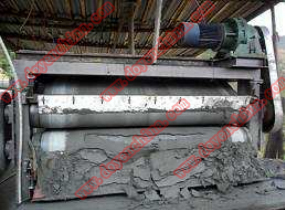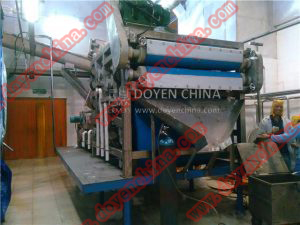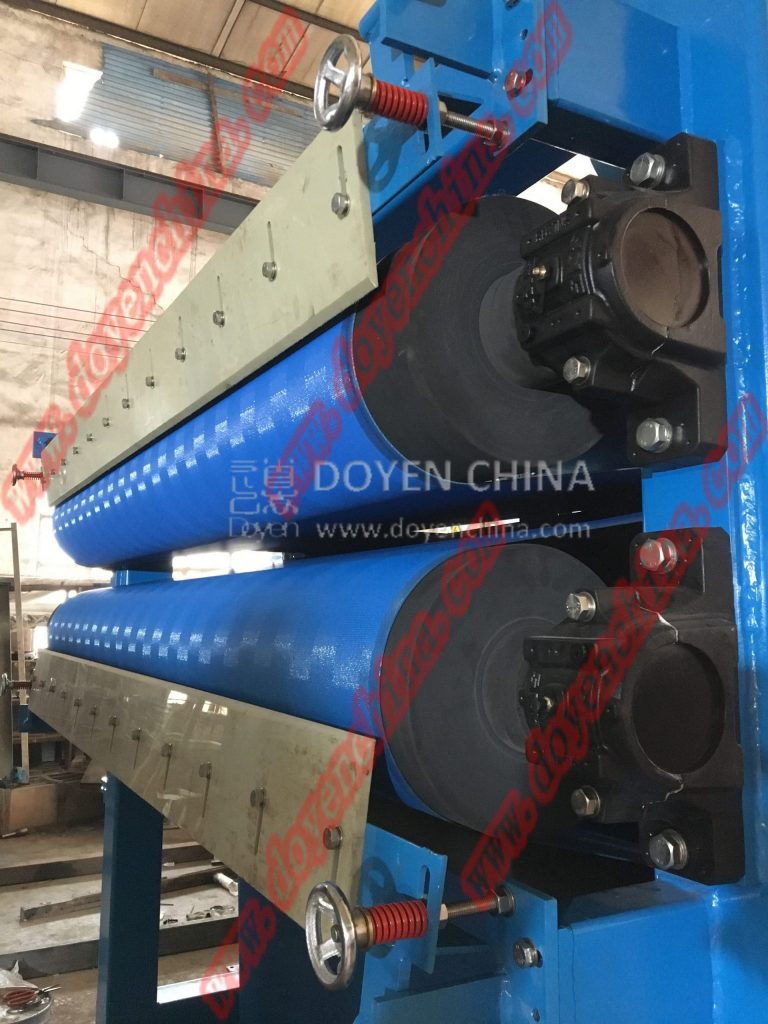

Tel:
+86-757-8633-0278
Email:doyen@doyenchina.com
Fax:+86-757-86287390
Address:Room 201, Building No. 24, Yicui Rose Garden, No. 2, Jihua 7 Road, Chancheng District, Foshan City, Guangdong Province, China 528000.
The belt filter press is mainly composed of driving device, frame, roller, upper filter belt, lower filter belt, filter belt tensioner, filter belt cleaning device, unloading device, pneumatic control system and electrical control system.
The refined wet slag raw material (or solid-liquid mixture of slag) is continuously fed into the hopper through a screw pump or conveyor (the discharge of the hopper can be adjusted), driven by the driving roller, the screw press wheel will evenly distribute the upper and lower filter belts , Thus starting gravity dehydration, the material moves forward with the filter belt and enters the wedge-shaped zone for initial pressure dehydration. After entering the low pressure zone, the large screen with L-shaped bead immediately squeezes out a large amount of water, and ensures that the water is discharged from both sides, and then enters the high pressure zone of the squeeze pinch roller. The upper and lower filter belts bypass several groups of pinching kuns with decreasing diameters, and a large amount of water is slowly and strongly squeezed to form a squeezable filter cake. On the other hand, the filter belt is wound into an “S” shape, resulting in an increase in the shear force of the surface pressure. Under the tension of the filter belt, the upper and lower filter belts exert pressure on the material to discharge a small amount of water in the material. As the diameter of the slag wheel gradually decreases, the pressure between the filter belts gradually increases, and a small amount of water is continuously discharged. A large amount of water in the material is squeezed out by the strong pinch wheel, and the filtrate is collected through the water receiving tank. After the upper and lower filter belts are separated, the dewatered residue cake on the working surface of the upper and lower filter belts is scraped off by the wear-resistant scraper device. Finally, scrub the filter belt with high-pressure water and a brush under the cleaning system to remove the residue in the mesh seam and maintain continuous dehydration production.

Reduce the water content of the sludge in the thickening tank
The belt filter press is mainly composed of driving device, frame, roller, upper filter belt, lower filter belt, filter belt tensioner, filter belt cleaning device, unloading device, pneumatic control system and electrical control system.
The refined wet slag raw material (or solid-liquid mixture of slag) is continuously fed into the hopper through a screw pump or conveyor (the discharge of the hopper can be adjusted), driven by the driving roller, the screw press wheel will evenly distribute the upper and lower filter belts , Thus starting gravity dehydration, the material moves forward with the filter belt and enters the wedge-shaped zone for initial pressure dehydration. After entering the low pressure zone, the large screen with L-shaped bead immediately squeezes out a large amount of water, and ensures that the water is discharged from both sides, and then enters the high pressure zone of the squeeze pinch roller. The upper and lower filter belts bypass several groups of pinching kuns with decreasing diameters, and a large amount of water is slowly and strongly squeezed to form a squeezable filter cake. On the other hand, the filter belt is wound into an “S” shape, resulting in an increase in the shear force of the surface pressure. Under the tension of the filter belt, the upper and lower filter belts exert pressure on the material to discharge a small amount of water in the material. As the diameter of the slag wheel gradually decreases, the pressure between the filter belts gradually increases, and a small amount of water is continuously discharged. A large amount of water in the material is squeezed out by the strong pinch wheel, and the filtrate is collected through the water tank. After the upper and lower filter belts are separated, the dewatered residue cake on the working surface of the upper and lower filter belts is scraped off by the wear-resistant scraper device. Finally, scrub the filter belt with high-pressure water and a brush under the cleaning system to remove the residue in the mesh seam and maintain continuous dehydration production.

Reduce the water content of the sludge in the thickening tank
At the initial stage of design, it should be considered to increase the volume of the thickening tank appropriately, which can increase the settling time of the sludge and reduce the water content of the sludge in the thickening tank to a certain extent. In order to reduce the water content of the sludge in the secondary settling tank, it is necessary to increase the settling time of the activated sludge in the secondary settling tank, but this method is not easy to master. If the sludge settling time is not well controlled, it is easy to cause too much sludge in the secondary settling tank, which will seriously affect the effluent quality.
When the aerobic tank SV30 is normal, intermittent sludge replenishment is used, that is, the remaining sludge is discharged into the thickening tank. When the outlet of the thickening tank changes from supernatant to turbid sludge, the sludge replenishment is stopped, and the sludge in the thickening tank is settled. After time, the remaining sludge is added to the thickening tank, and so on.
Increase the proportion of activated sludge in the thickening tank
The dissolved liquid in the thickening tank is almost zero. If the mud pressing operation is not carried out for a day, the sludge in the thickening tank will be anaerobic digested, which will have a certain impact on the subsequent mud pressing operation. Therefore, before the mud pressing operation, the remaining activated sludge in the secondary settling tank needs to be injected into the thickening tank to increase the proportion of activated sludge in the thickening tank to ensure subsequent mud pressing operations.
Control the appropriate mud-drug ratio
The amount of PAM is determined by the sludge flow rate, sludge moisture content, activated sludge ratio and PAM concentration, and the influencing factors are complex. Therefore, it is necessary to rely on the experience of the operator to judge the amount of polyseneamide. In principle, the solid-liquid separation effect is good after the slurry and the medicine are mixed, and tiny sludge particles can be formed. Free water can quickly seep through the filter cloth. After the sludge and the filter cloth are separated at the discharge port, there is no sticky sludge on the filter cloth. The ratio of mud medicine is reasonable. The main PAM concentration has been tested with different polyacrylamide concentrations for many times, and it is found that when the polyacrylamide concentration is between 0.6 and 0.8, the compacting effect is the best. While saving drugs, it can speed up the separation of free water and sludge and increase sludge production. Low-concentration PAM can also reduce the water content of sludge after dehydration. PAM concentration is between 0.6 and 0.8, which can reduce the water content of sludge to 60%-70%.

Ensure the permeability of the filter cloth
The quality of reclaimed water directly affects the permeability of the filter cloth. Therefore, the detection of hard suspended solids in water should be carried out before reclaimed water is used. If the water demand of the mud press cannot be met, a reclaimed water filtration system should be added to improve the quality of reclaimed water, or a filter screen should be added at the front of the nozzle of the mud press to meet the spray water demand of the mud press.
The ratio of mud to medicine also affects the permeability of the filter cloth. Therefore, in the normal production process, the ratio of sludge to PAM is well prepared to ensure the permeability of the filter cloth and increase production.
Ensure the stability of the mud press
Lubricate the bearings regularly to ensure the lubricity of the bearings and rotors and prevent frequent wear of the bearings. Reasonably adjust the speed of the filter cloth and the height of the distribution plate to prevent the filter cloth from being twisted or even torn due to uneven force, and to prevent the bearing from wearing due to uneven force.
Increase the mixing time of mud and medicine
In the past, the customer’s pipeline mixer was connected to a 2-meter pipeline at the feed inlet. The mixing time after the mud medicine is mixed is too short, the mud medicine is not uniformly mixed, and the mud water is not completely separated, resulting in less mud output per unit time of the mud press. After analyzing the reason, a 15m pipeline was added between the pipeline mixer and the feed inlet to fully mix the mud and the medicine in the pipeline, the mud-water separation effect is good, and the mud output is increased.
Appropriately reduce the mesh number of the filter cloth in the concentration section
In the thickening section, the mesh number of the filter cloth is reduced, the gap of the filter cloth is increased, free water can quickly flow out of the filter cloth, the moisture content of the sludge in the filter press section is reduced, and the sludge output of the filter press is increased.
The belt filter press has a compact structure and a small footprint, which is suitable for sludge dehydration treatment in small and medium-sized mines. It is the most common type and can be widely used in various sludge dewatering treatments. The thick water filter with the ultra-long filter belt can more thoroughly dewater the free water in the sludge, increase the sludge processing capacity, and effectively reduce the water content of the mud cake.
Doyen specializes in providing belt press equipment for the Southeast Asian market. Welcome to visit our workshop and formulate a more scientific plan based on the actual situation of your company. Welcome to visit joyce@doyenchina.com or visit https://www.doyenchina.com.
Dec-28-2020
admin

 +86-757-8633-0278
+86-757-8633-0278 doyen@doyenchina.com
doyen@doyenchina.com Sitemap
Sitemap